The color orange symbolizes joy, cheering up, friendship, and positive vibes. Elevate your outdoor space with orange-flowering plants and give your garden a much-needed spring makeover. There are more than 400,000 varieties of flowers available in orange shades to choose from for a vibrant and aesthetically pleasing living space.
Read here to learn more about orange flowers and modify your surroundings with this joyous hue. Take a brief look at the handpicked list of the 40 best orange flowers, along with the essential information needed for their healthy growth.
Butterfly Weed
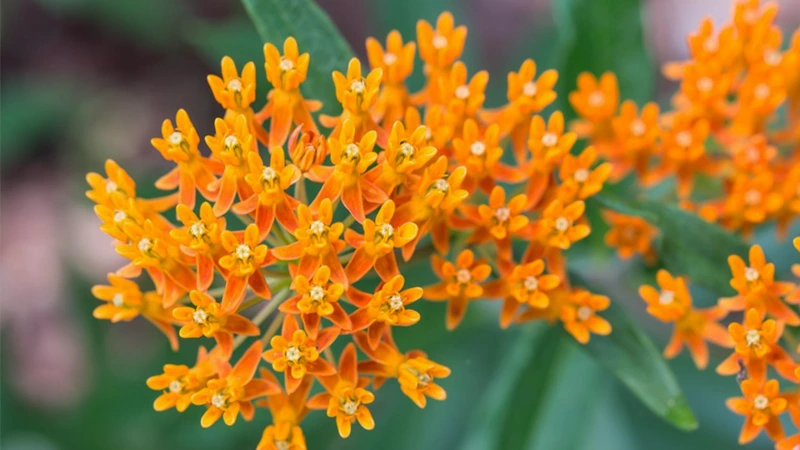
Butterfly Weed is a milkweed plant native to the Eastern and Southern United States. It usually blooms out in the summer and grows up to 1 to 3 feet high. This flower also attracts pollinators such as bees and butterflies because of its vibrant orangish color.
| Scientific Name: | Asclepias tuberosa |
| USDA Growing Zone: | 3 to 9 |
| Sun Exposure: | At least eight hours of full sun |
| Soil: | Preferably dry soil |
| Height: | 1 to 3 feet |
Calendula
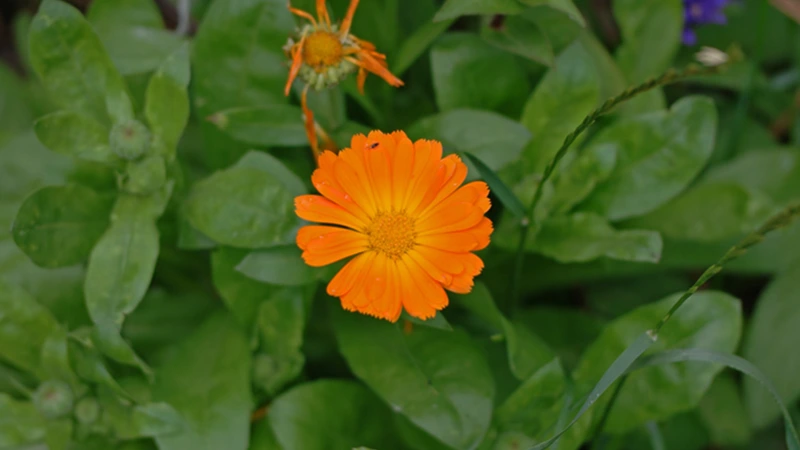
Calendula is also known as pot marigold; it originated from Southern Europe and has been used in medicines since the 12th century to cure minor diseases. This flower usually grows up to 1 to 3 feet tall and looks gorgeous with its original color contrast.
| Scientific Name: | Calendula officinalis |
| USDA Growing Zone: | 2 to 11; grows annually |
| Sun Exposure: | 6 to 8 hours of sunlight daily |
| Soil: | Medium-moisture soil preferred |
| Height: | 1 to 3 feet |
Canna Lily
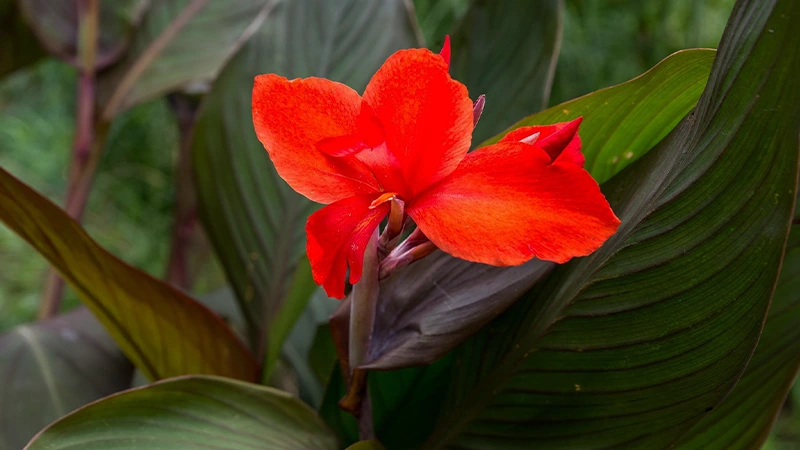
Canna Lilies are a sub-category of tropical-looking plants that originated in the American tropics. They can grow up to a height of 2 to 8 feet (2.44 m) and are mostly grown in warm climates, which makes them easy to cultivate. These flowers even attract pollinators such as bees and butterflies to elevate the garden space.
| Scientific Name: | Canna ‘Cleopatra’ |
| USDA Growing Zone: | 2 to 10 |
| Sun Exposure: | 6 hours of direct sunlight |
| Soil: | Rich garden soil |
| Height: | 2 to 8 feet |
Chinese Lantern Plant
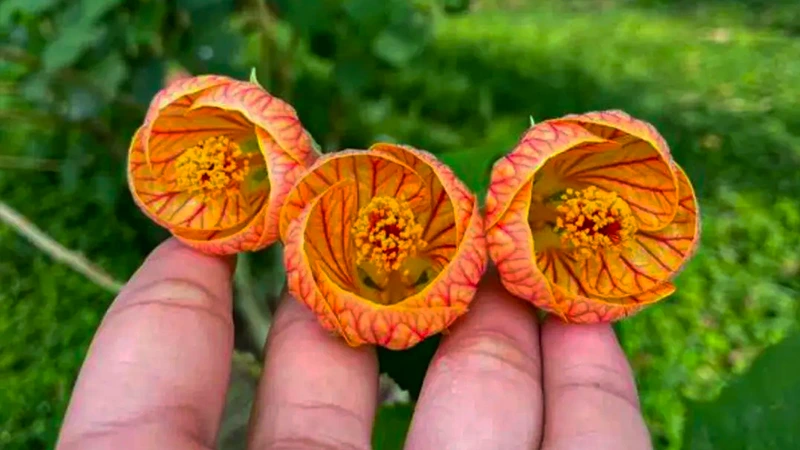
The Chinese Lantern Plant is well recognized for its lantern seed pods; it originated from the regions of Europe and Asia. This flower mostly grows in late summer and gains attention with its visually striking features and rose gold bud in the center.
| Scientific Name: | Physalis alkekengi |
| USDA Growing Zone: | 3 to 9 |
| Sun Exposure: | 7 to 8 hours of full sunlight |
| Soil: | Well-Drained Soil |
| Height: | 2 to 3 feet |
Cigar Plant
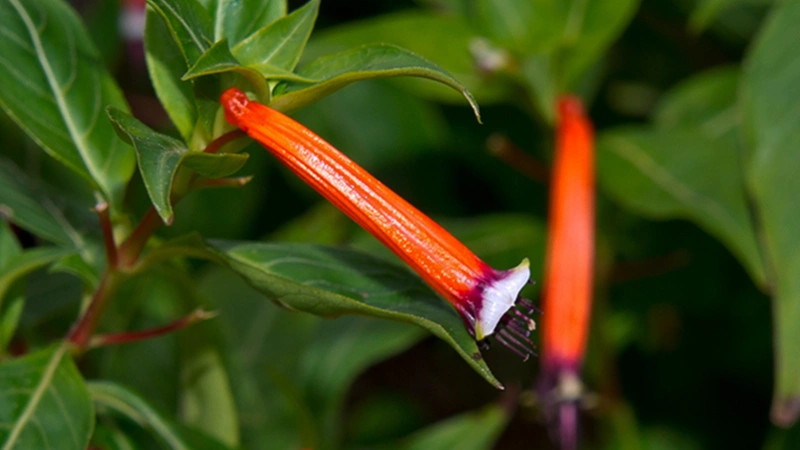
The Cigar Plant is a long-lasting shrub that resembles lit cigars; it is bright red and usually grows in warmer areas. This flowering plant can go up to 1 to 3 feet and is usually suitable for elevating your home garden with its striking color.
| Scientific Name: | Cuphea ignea |
| USDA Growing Zone: | 9 to 11 |
| Sun Exposure: | Full sun of 5 to 7 hours |
| Soil: | Loamy Soil or well-drained soil |
| Height: | 1 to 3 Feet |
Climbing Penstemon
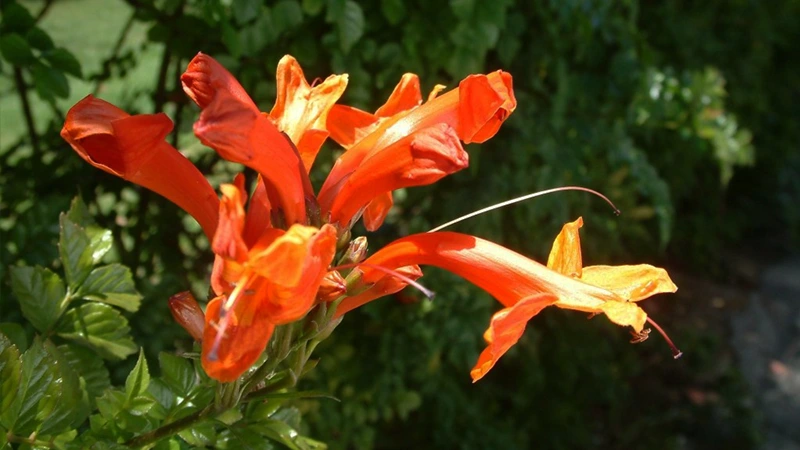
The Climbing Penstemon is a perennial plant, usually recognized for its height, which goes up to 4 to 5 feet (1.52 m) in general, and the bell-shaped blooms on it in red, blue, or white. It originated in Native America, but is now easier to grow in warmer areas, too.
| Scientific Name: | Penstemon floridus |
| USDA Growing Zone: | 4 to 9 |
| Sun Exposure: | Full sun; 5 to 7 hours of direct sunlight |
| Soil: | Sandy soil |
| Height: | 4 to 5 feet |
Lantana
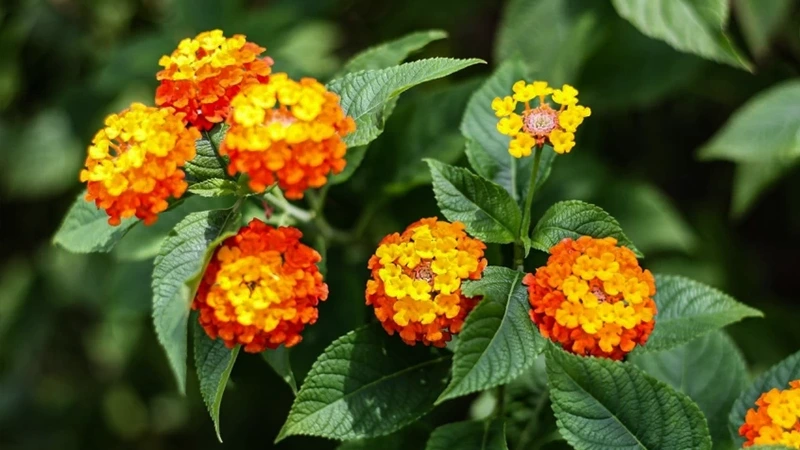
Lantana is a perennial shrub, native to the American tropics; this plant is widely famous for its colorful, tubular flowers and growing habitat. These flowers are now found in frost-free climates, with a bright group of colors orange, yellow, and red.
| Scientific Name: | Lantana camara |
| USDA Growing Zone: | 8 to 11 |
| Sun Exposure: | Direct sunlight; Full sun |
| Soil: | Poor or Average Soil |
| Height: | 2 to 6 feet |
Orange Lily
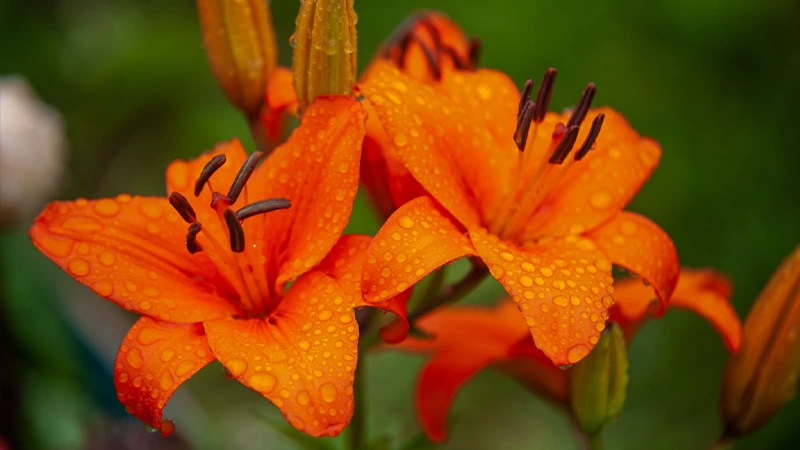
Orange Lily is native to Europe, specifically France and Italy, known for its sparkling, bright orange color. This flower usually grows up to 2 to 4 feet (1.22 m) and blooms from late spring to summer. Additionally, you can keep it inside your home, as it only needs partial sunlight to bloom.
| Scientific Name: | Lilium bulbiferum |
| USDA Growing Zone: | 4 to 8 |
| Sun Exposure: | Partial shade of sun for 3 to 5 hours |
| Soil: | Well-drained soil |
| Height: | 2 to 4 feet |
Flowering Maple
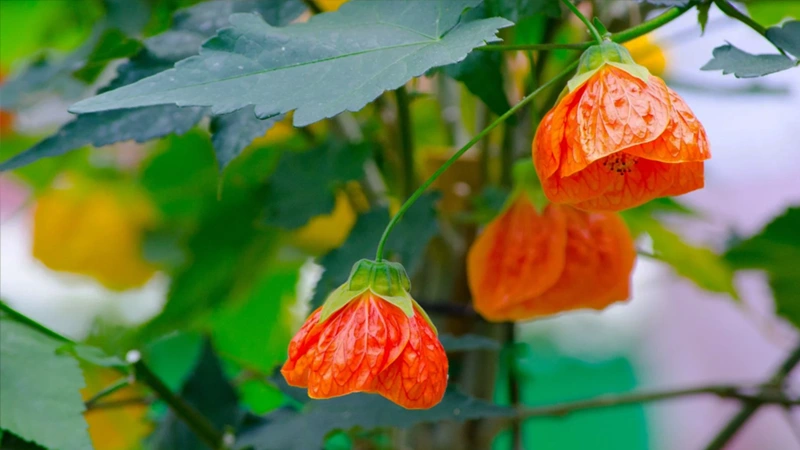
Flowering Maple is a category of subtropical plants; it grows in five different colors: orange, yellow, red, pink, and white and grows up to 2 to 4 feet (1.22 m). This flower is sensitive to frost, so you’ll need to move it inside in winter to keep it healthy and growing.
| Scientific Name: | Abutilon x hybridum |
| USDA Growing Zone: | 9 to 10 |
| Sun Exposure: | Full sunlight of 3 to 5 hours |
| Soil: | Medium Moisture |
| Height: | 2 to 4 feet |
Orange Ballerina Tulip
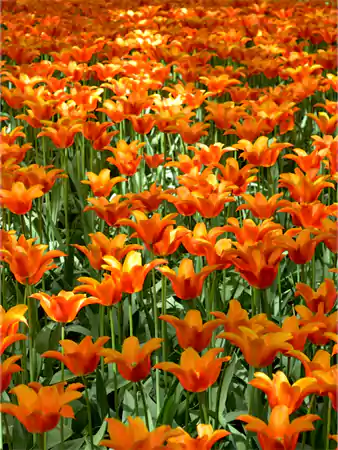
Orange Ballerina is categorized under the tulips category. They usually bloom near spring and go up to 6 to 12 inches (30.48 cm) in height, which is extremely rare in this category. It is bright orange, with a hint of yellow and red hues on it. Its fragrance is the main reason behind its popular choice among anthophiles.
| Scientific Name: | Tulipa ‘Orange Ballerina’ |
| USDA Growing Zone: | 3 to 8 |
| Sun Exposure: | Full sun; direct sunlight |
| Soil: | Rich and highly textured |
| Height: | 4 to 6 feet |
Oriental Poppy
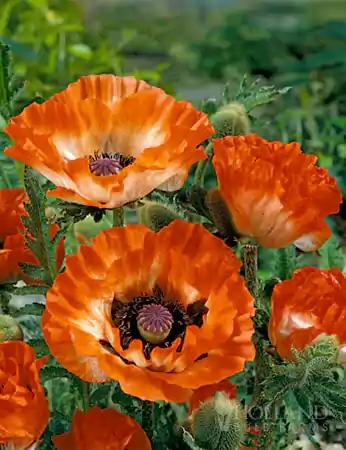
The Oriental Poppy is a long-lasting flower native to Turkey and North Iran. This flower is particularly famous for its large and vibrant orange and white petals that can grow up to 10 inches (25.4 cm) in diameter. It majorly blooms from late spring to mid-summer.
| Scientific Name: | Papaver orientale |
| USDA Growing Zone: | 3 to 8 |
| Sun Exposure: | Full sun; direct sunlight |
| Soil: | Well-drained soil |
| Height: | 2 to 4 feet |
Orange Calendula
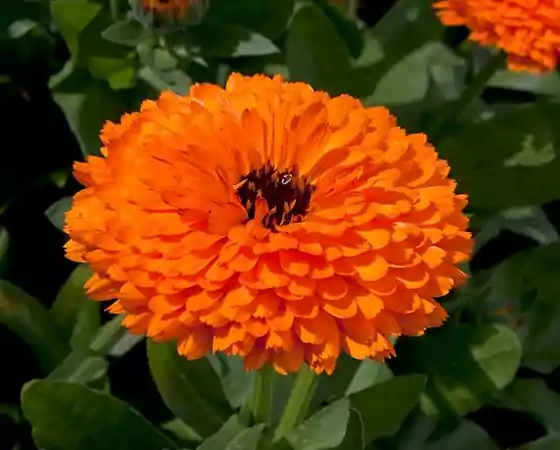
Orange Calendula, also known as yellow marigold, is a flowering plant from the Asteraceae family with bright yellow and orange hues. It can grow up to 2 to 3 feet (0.91 m) in height and is even used as an herbal remedy for anti-inflammatory diseases.
| Scientific Name: | Calendula officinalis |
| USDA Growing Zone: | 2 to 11 |
| Sun Exposure: | Full sunlight; 5 to 6 hours of direct sunlight |
| Soil: | Fertile soil |
| Height: | 2 to 3 feet |
Montbretia
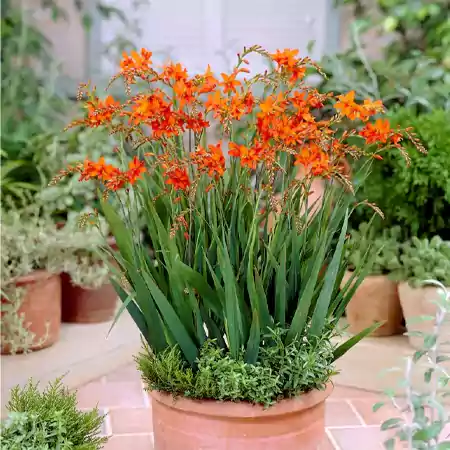
Montbretia is a long-lasting Iridaceae family flower native to southern and eastern Africa. This flower is particularly famous for its sword-shaped leaves that can reach up to 3 to 4 feet in height and fruitfully bloom with zig-zag petal heads.
| Scientific Name: | Crocosmia x crocosmiiflora |
| USDA Growing Zone: | 5-9 |
| Sun Exposure: | Partial Sun |
| Soil: | Well-drained soil |
| Height: | 3 to 4 feet |
African Tulip Tree
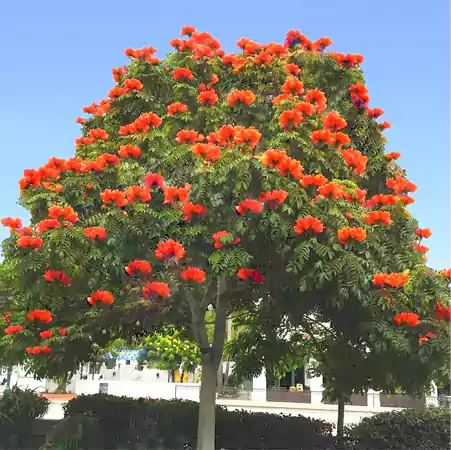
The African Tulip Tree is a large and evergreen tree plant native to tropical Africa. This flowering tree is generally very tall; it can go up to 23–82 feet tall and is also widely popular because of its reddish and orange flowers that complement each other.
| Scientific Name: | Spathodea campanulata |
| USDA Growing Zone: | 10 to 11 |
| Sun Exposure: | Full Sun; Direct Sunlight |
| Soil: | Partial to Full Sun |
| Height: | 20 to 25 feet |
King Zinnia
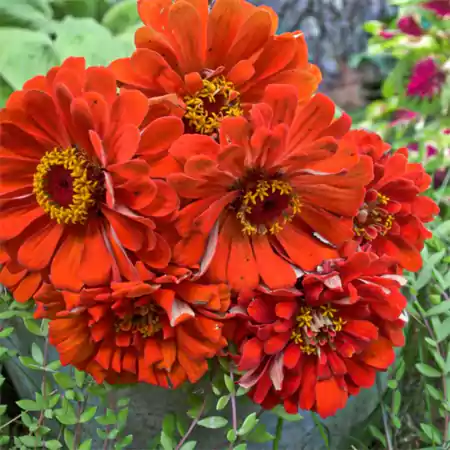
The King Zinnia is a sub-category flower of the zinnia floral structure; they are widely known for their large and blissful bloom in orange, pink, and red color. These flowers usually survive in sunny, warm, and humid conditions and are widely used for gifting purposes, flower arrangements, and decorations.
| Scientific Name: | Zinnia elegans |
| USDA Growing Zone: | 3 to 10 |
| Sun Exposure: | Full sun; 6 to 8 hours of sunlight |
| Soil: | Fertile soil |
| Height: | 2 to 4 feet |
Orange Cosmos
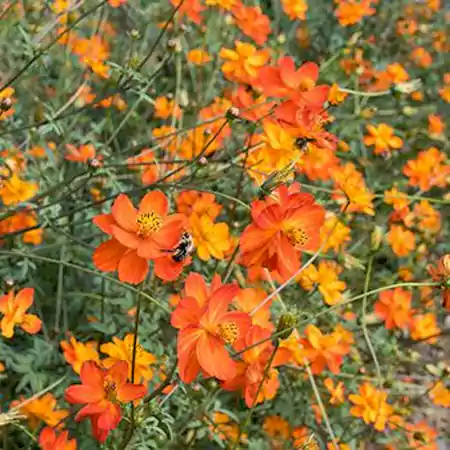
Orange Cosmos, often known as garden cosmos or Mexican aster, is a vibrant flowering plant that is from the Asteraceae family. It is widely loved for contrasting vibrant daisy-like flowers in pink, red, purple, and orange. They can be paired up with different colored plants to further modify one’s outdoor space.
| Scientific Name: | Cosmos bipinnatus |
| USDA Growing Zone: | 2 to 11 |
| Sun Exposure: | Full Sun; Direct Sunlight |
| Soil: | Well-drained soil |
| Height: | 2 to 6 feet |
Nasturtium
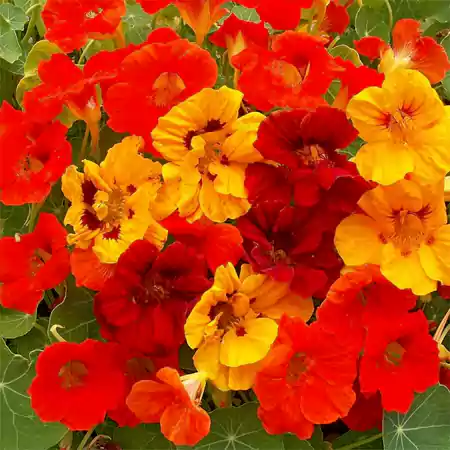
Nasturtium is an annual flowering plant from the Tropaelaceae family. It is mostly bright yellow, orange, and red. This flower is widely famous for its funnel-shaped petals and can grow up to 6 cm in diameter. Additionally, it is even edible and used in dishes of South America.
| Scientific Name: | Tropaeolum majus |
| USDA Growing Zone: | 2 to 11 |
| Sun Exposure: | Full sunlight |
| Soil: | Well drained soil |
| Height: | 2 to 3 feet |
American Bittersweet
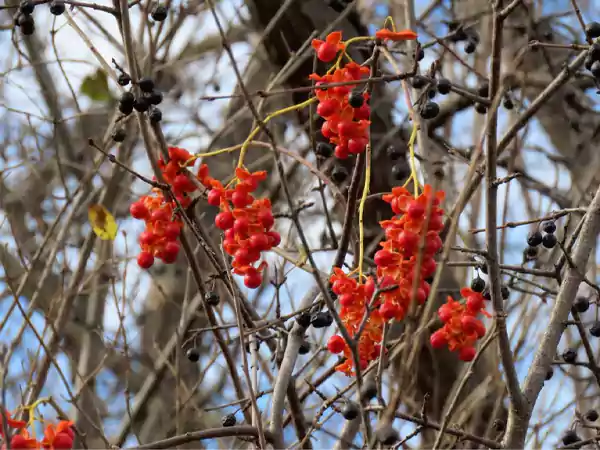
American Bittersweet is a vine native to North America. The leaves of this flower are oval, long up to 2 to 4 inches, and textured. They can grow up to 30 feet long. Additionally, the fruits of this flowering plant appear in spring as yellow and orange-colored capsules.
| Scientific Name: | Celastrus scandens |
| USDA Growing Zone: | 3 to 8 |
| Sun Exposure: | Partial sunlight |
| Soil: | Moisture soil |
| Height: | Upto 30 feet |
Mexican Sunflower
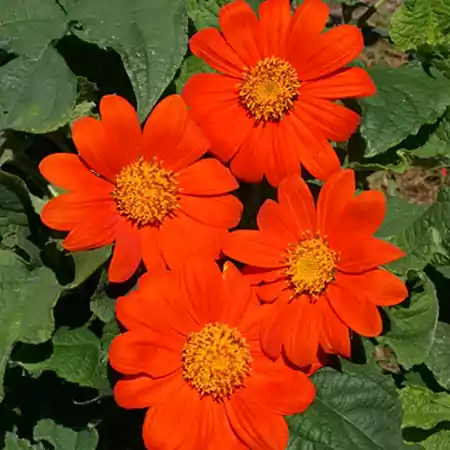
The Mexican Sunflower is a tall and annual plant native to Mexico and Central America. This flower is widely known for its dark green leaves with a fuzz and bright red to orange bud in the middle. They bloom from mid-summer to early fall and need an ample amount of water to grow beautifully.
| Scientific Name: | Tithonia rotundifolia |
| USDA Growing Zone: | 2 to 11 |
| Sun Exposure: | Direct Sunlight; full sun |
| Soil: | Medium Moisture |
| Height: | 4 to 6 feet |
Crown Imperial
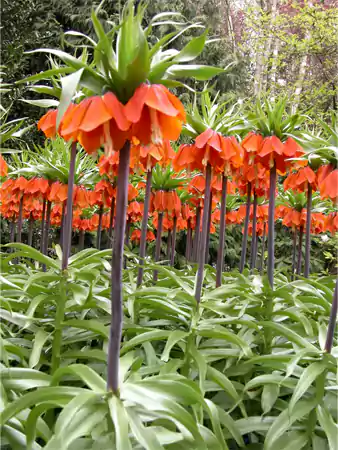
Crown Imperial is a flowering plant native to Turkey; it usually blooms during spring to late fall with vibrant orange and yellow flowers. This flowering plant grows up to a height of 5-7 feet and is widely known as an ornamental plant.
| Scientific Name: | Fritillaria Imperialis ‘Aurora’ |
| USDA Growing Zone: | 5 to 8 |
| Sun Exposure: | Partial sunlight to Full Sunlight |
| Soil: | Medium Moisture |
| Height: | 5 to feet |
Sunset DayLily
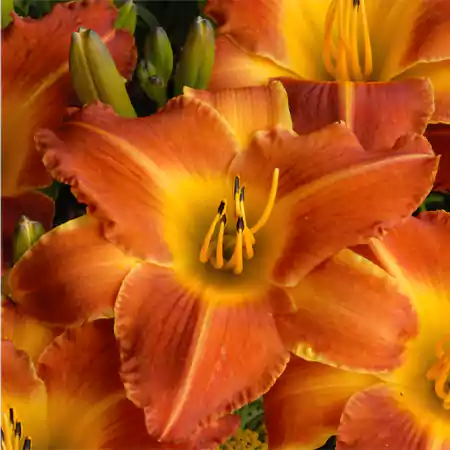
Sunset DayLily, also known as daylilies, grows in a clump doesn’t reach much height and is widespread in nature and texture. This flower grows in mostly humid and warmer regions. It blooms beautiful, showy flowers in summer, which are even edible.
| Scientific Name | Hemerocallis ‘Bright Sunset’ |
| USDA Growing Zone | 3 to 9 |
| Sun Exposure | Full sun; direct sunlight |
| Soil | Well-drained and medium-moisture soil |
| Height | 3 to 4 feet |
Orange Glow Begonia
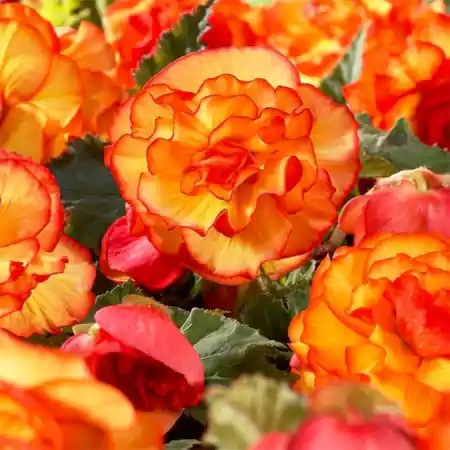
Orange-Glow Begonia is quite a big flower filled with frost-tender yellowish elements in the middle. This flower comes in various colors, but the vivid orange is the most cherished among all; it blooms more beautifully in humid temperatures.
| Scientific Name | Begonia ‘Orange Glow’ |
| USDA Growing Zone | 10 to 11 |
| Sun Exposure | Full sun; direct sunlight |
| Soil | Rich soil |
| Height | 2 to 3 feet |
California Poppy
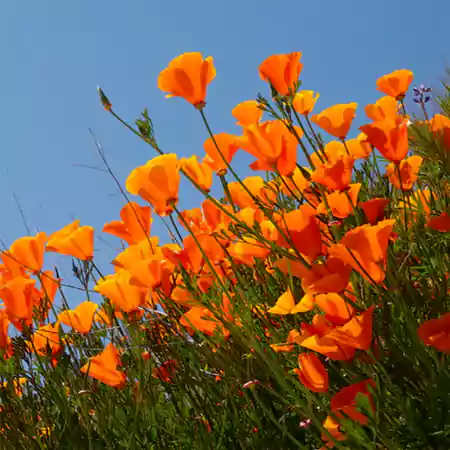
California Poppy is a perennial flowering plant type native to North America and Central America. This flower will elevate your outdoor area with its vibrant color, texture, and cup-shaped four petals of orangish color. Furthermore, this plant goes up to 1-2 feet and is also known as an ornamental plant in some regions.
| Scientific Name | Eschscholzia californica |
| USDA Growing Zone | 6 to 10 |
| Sun Exposure | Full sunlight; a direct hit of sunlight |
| Soil | Sandy; well drained |
| Height | 1 to 2 feet |
Gerbera Daisy
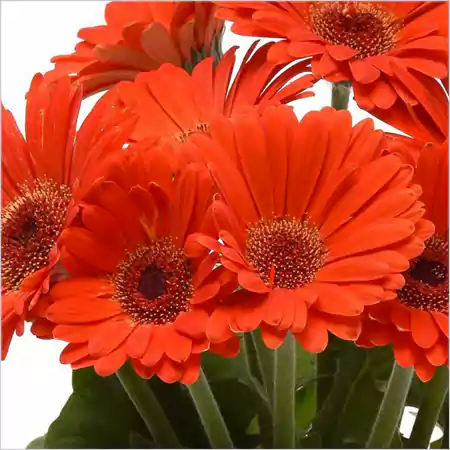
Gerbera Daisy is a unique kind of daisy perennial plant native to South Africa. This flower is widely known for its ultra-thin petals coming from the center. It usually blooms from September to December and is the most adored flower in the variety of daisies.
| Scientific Name | Gerbera Jamesonii |
| USDA Growing Zone | 9 to 11 |
| Sun Exposure | Full Sun |
| Soil | Slightly acidic soil |
| Height | 3 feet (0.91 m) |
Carnation
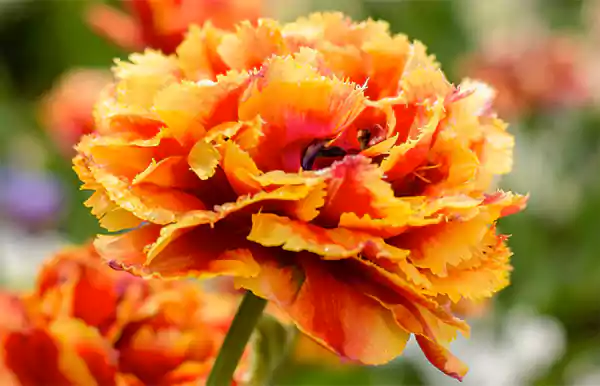
Carnations are long-stemmed flowering plants known for their ruffed petals in a variety of colors. But the most admired ones are the yellow and orange. They grow individually or in groups of up to 5 inches (12.7 cm), approximately in height and 2 inches (5.08 cm) in diameter.
| Scientific Name | Dianthus caryophyllus |
| USDA Growing Zone | 7 to 10 |
| Sun Exposure | Partial to Full Sunlight |
| Soil | Moist soil needed |
| Height | 2.5 feet (0.76 m) |
Marigold
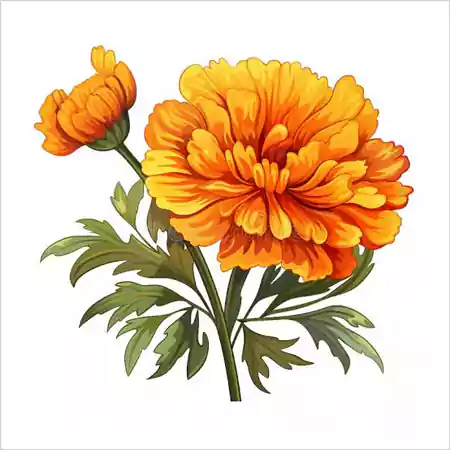
The Marigold flower is traditionally suitable for the garden area because of its variety, low maintenance, and pom-shaped structure. It even helps keep the insects away from the other plants. This flower is even used for spiritual purposes in various regions, especially in Asia.
| Scientific Name | Tagetes |
| USDA Growing Zone | 2 to 11 |
| Sun Exposure | Full Sun; Direct Sunlight |
| Soil | Drained soil |
| Height | 1 to 4 feet |
Firebird Coneflower
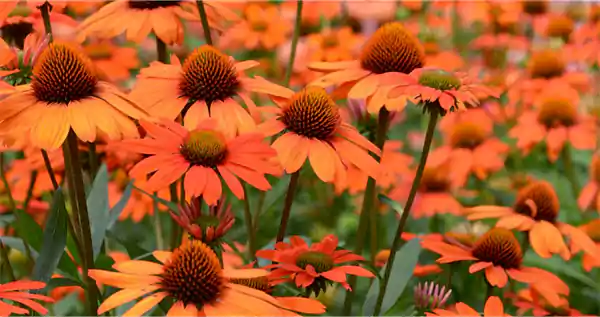
Firebird Coneflower is a perennial flower that has a shuttlecock-shaped flower. Blooming like fire itself, this flower has orange and red colors, with a brownish tone in the center. Furthermore, this flower usually blooms from early June to late August, and it can bloom up to 25 inches tall and 20 inches wide, which is very rare to witness.
| Scientific Name | Echinacea purpura |
| USDA Growing Zone | 3 to 8 |
| Sun Exposure | Full sun; direct sunlight |
| Soil | Well-Drained Soil |
| Height | 1 to 3 feet |
Gladiolas
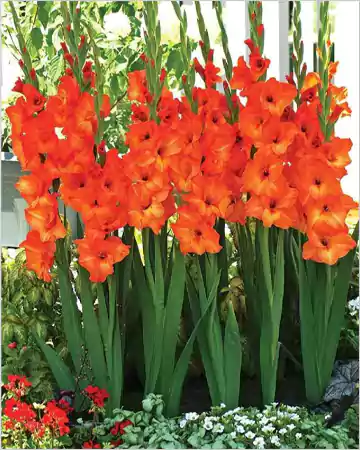
Gladiolas are often known as sword lilies. They have green sword-shaped leaves and orange funnel-shaped blooms on them. These flowers can grow up to 2-3 feet in height and are popularly known for indoor decoration, gifting, and bouquets.
| Scientific Name | Finishing Touch gladiolus |
| USDA Growing Zone | 7 to 10 |
| Sun Exposure | Full sun; direct sunlight |
| Soil | Sandy Soil |
| Height | 2 to 4 feet |
Lantern Dahlia

Lantern Dahlia is a flowering plant from the Aster family, native to Central America and Mexico. This flower is known for its wide variety of colors and texture. As of now, more than 200 dahlias are available in the market with different specifications. Additionally, it takes only 70–80 days to bloom beautifully.
| Scientific Name | Dahlia pinnata Cav |
| USDA Growing Zone | 8 to 11 |
| Sun Exposure | Full Sun |
| Soil | Loamy Soil |
| Height | 3 to 4 feet |
Iris
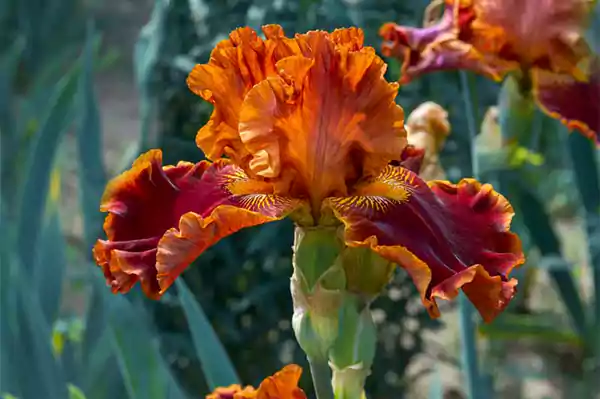
Iris stands out as a unique structured flower from the Asteraceae family plant; it is available in different varieties of colors and textures. Usually, this flower is famous for its petals, as its 6 petals are arranged in segments; three of them are upward, and three of them are downward.
| Scientific Name: | Iris spp |
| USDA Growing Zone: | 3 to 9 |
| Sun Exposure: | Full sun; direct sunlight |
| Soil: | Well-drained Soil |
| Height: | 5 to 6 inches |
Diverse options and categories are available in orange flowers; you can pair up these with different colors to brighten up your outdoor space. Now, take a glance at some more orange flowers for your garden area in the upcoming section to give your outdoor space a lively spirit.
10 Best Orange Flowers Plants Suitable for Your Garden Area
Till now, we have discussed 30 orange flowers in great detail. Now let’s quickly review this table to know some other ecstatic orange flowers that will instantly uplift the spirit of your garden area, making it a more joyous spot.
| Flower Name | Scientific Name | USDA Growing Zone | Sun Exposure | Soil | Plant Size |
|---|---|---|---|---|---|
| Impatiens | Impatiens walleriana | 10 to 11 | Full sun | Well-drained | 2-3 ft |
| Lily | Lilium | 8 to 11 | Full sun | Moist Soil | 3-4 ft |
| Million Bells | Calibrachoa | 9 to 11 | Partial Sun | Well-drained | 5-12 ft |
| Orange Bells | Tecoma fulva | 8 to 11 | Full Sun | Moist Soil | 10-15 ft |
| Persian Buttercup | Ranunculus asiaticus | 8 to 10 | Full Sun | Well-drained | 2-3 ft |
| Snapdragon | Antirrhinum | 9 to 10 | Partial Sun | Moist Soil | 6-9 ft |
| Spanish Gold | Grindelia ciliata is a Grindelia. | 5 to 8 | Full Sun | Well-drained | 10-25 ft |
| Trumpet Vine | Campsis radicans | 4 to 9 | Full Sun | Well-drained | 10-15 ft |
| Blackberry Lily | Iris domestica | 4 to 9 | Full Sun | Well-drained | 1-3 ft |
| Frangipani | Frangipane | 10 to 11 | Full Sun | Well-drained | 20-25ft |
Summing Up!
Orange flowering bushes make your home beautiful, along with their surreal beauty and benefits. Some of them serve as meaningful elements in curing diseases, attracting pollinators to your garden, and props for gifting bouquets.
Additionally, we have provided the essential details for growing a healthy plant. These flowers will elevate your outdoor space, and you can make an aesthetically pleasing balcony garden with its vibrant and bright color.
Do orange flowers look well planted in the garden area?
Yes, you can pair up orange flowers with yellow and red, and it makes an amazing eye-pleasing contrast in your garden area.
Which orange flower grows up fast?
Marigolds, carnations, zinnias, and cosmos grow up fast under favorable conditions and a healthy growing style.
Which orange flower is popular for gifting?
Butterfly weed, Lantana, Zinnia, and Calendula are everyone’s popular choices for gifting.






